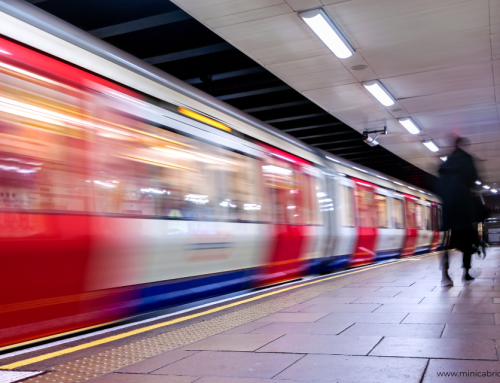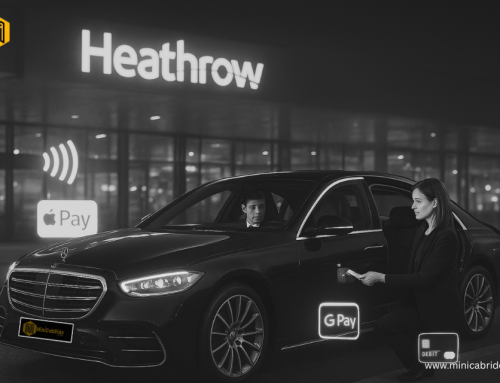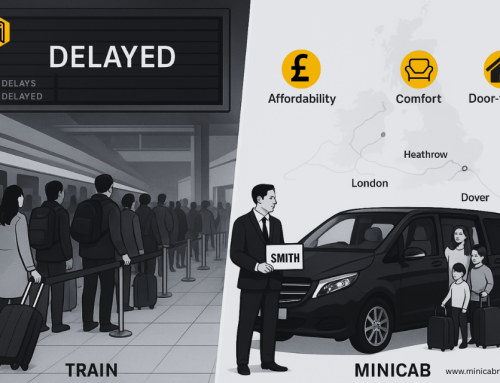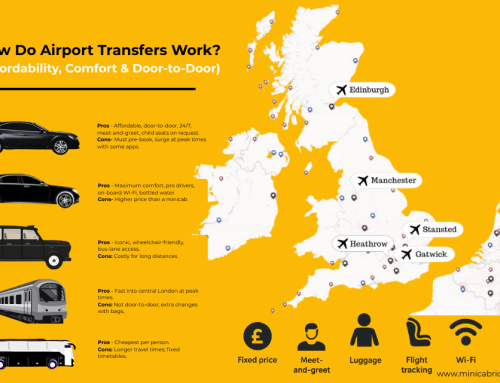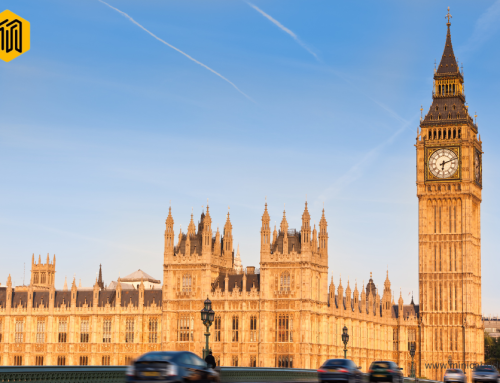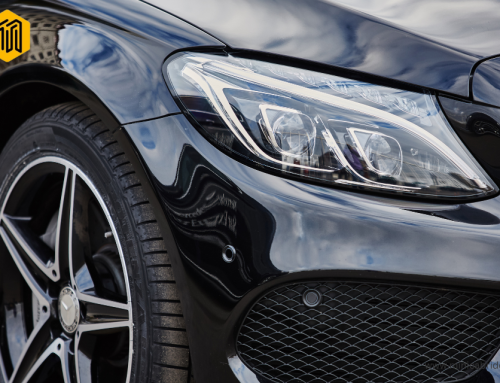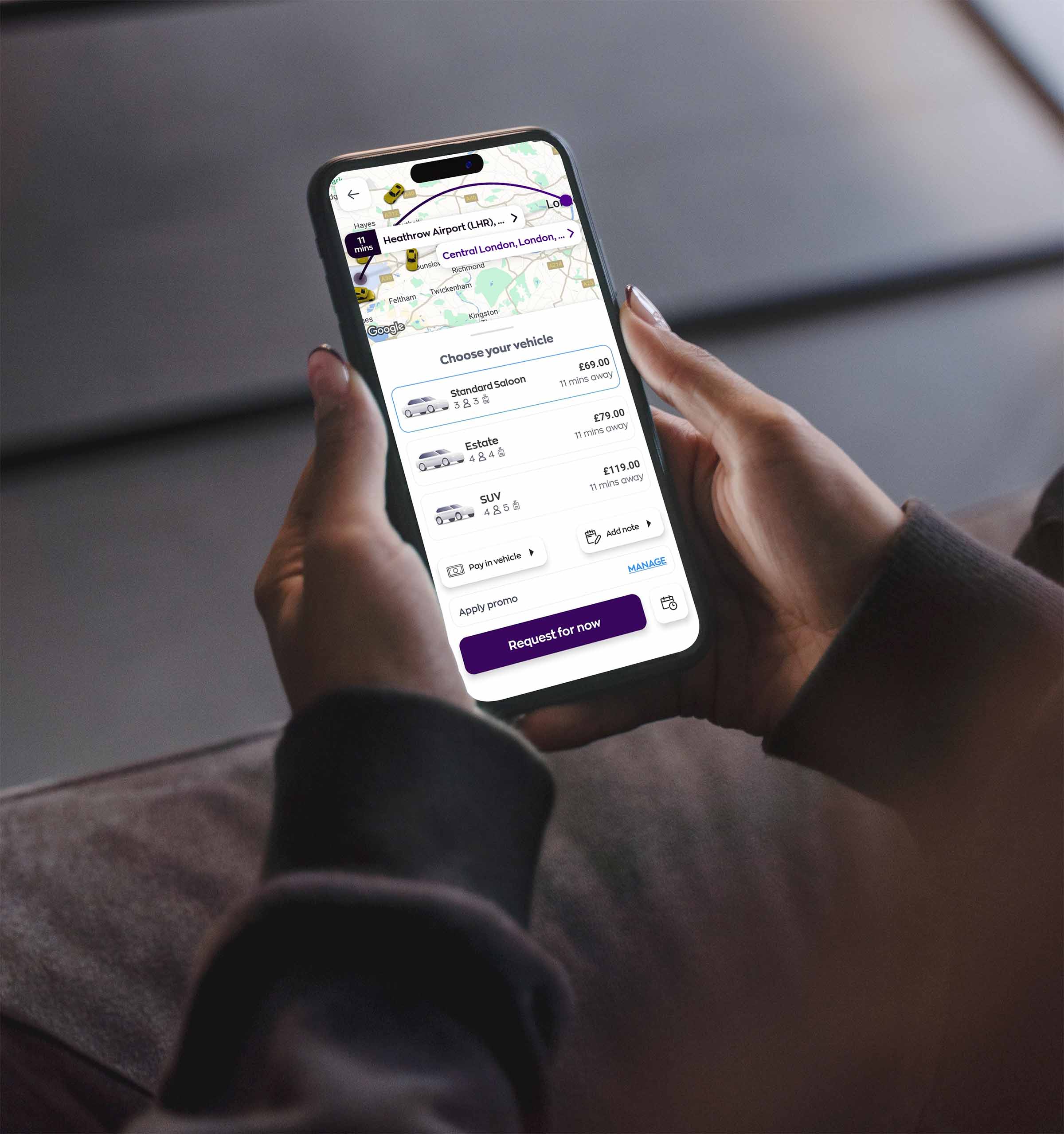
Solo travel in the UK is generally safe, and with a bit of planning, your ground transfers can be smooth and stress-free—whether you’re heading from Heathrow after a long-haul flight, boarding a cruise at Southampton , Portmouth or Dover, or getting across town late at night. The key is knowing the difference between taxis and private hire (minicabs), using licensed providers, and taking advantage of modern safety features built into booking platforms.
Table of Contents
ToggleThe landscape at a glance (and why it matters)
- The market is large and regulated. England had 313,000 licensed taxis and private-hire vehicles in 2024, a 8.2% increase year-on-year, reflecting robust availability for travelers.
- Minicabs (PHVs) must be pre-booked—you cannot legally hail them in the street. This rule is at the heart of safer night travel because bookings create a digital trail of the driver, vehicle, and route.
- Women consistently report lower feelings of safety at night than men, making it even more important to choose the right booking method and share trip details.
Taxi vs Minicab (PHV): What’s safest for your situation?
Licensed taxis (“black cabs” in London):
- Can be hailed at ranks or on the street.
- At Heathrow, official taxi ranks are directly outside each terminal—drivers are fully licensed and have passed the Knowledge of London. Ideal if you prefer a walk-up option with no pre-booking.
Private Hire Vehicles (minicabs):
- Must be pre-booked by phone, app, or at an operator’s office. If a minicab stops and offers a ride without a booking, it’s illegal. Booking ensures you get driver + vehicle details and a record of your trip.
Which is “safer”?
Both are safe when used correctly. If you’re arriving at an airport or cruise terminal with luggage, pre-booking a PHV lets you lock in a fixed fare, receive driver details in advance, and share your ride info. If you prefer spontaneity or are uncomfortable with apps, licensed taxi ranks at airports and major stations are a solid, regulated fallback.
Booking safely: the checklist that actually works
Use licensed channels only.
- Taxis: take them from official ranks or hail in the street (where permitted).
- Minicabs: always pre-book via a licensed operator/app. You should receive confirmation with driver name/ID, vehicle reg, and booking reference—check these match before you get in.
Prefer platforms with built-in safety tech.
- Look for GPS-tracked trips, in-app emergency buttons, and “Share My Trip” features so a trusted contact can follow your route in real time.
Verify the car at the kerb.
- Check the number plate, make/model, and driver photo against your booking confirmation before opening the door. If anything doesn’t match, cancel and rebook.
Keep the booking trail.
- Screenshots of the booking and receipts help if you need to follow up with the operator or authorities later. (Many city safety campaigns centre on maintaining this audit trail.)
Sit smart, ride smart.
- Sit in the back, behind the front passenger seat; wear your seatbelt; keep valuables out of sight. Share your live trip link with a friend when travelling at night. (Met Police personal safety guidance.)
Night-time travel & women’s safety: what the evidence tells us
- Government-summarised ONS figures show women are less likely to feel safe walking alone after dark than men, which underlines the value of pre-booked, trackable transport and sharing your trip.
- London’s Safer Travel at Night initiative (TfL + police) has long targeted illegal minicabs; education and enforcement reduced cab-related sexual offences vs. the early 2000s—another reason to book, not “flag down”.
Night travel tips that stack the odds in your favour
- Book before you leave the venue (or set a pickup at a staffed, well-lit location).
- Avoid unbooked minicabs—no matter how persuasive the driver. It’s illegal and removes your protections.
- Message a contact with your live trip link and expected arrival time; if your app offers RideCheck or similar, turn it on.
- . If plans change mid-ride, update the destination in-app rather than negotiating off-app. That keeps the booking valid and traceable. (Best-practice guidance from safety campaigns and operators.)
Airport transfers: Heathrow, Gatwick, Manchester & beyond
Why pre-booking helps for airports
- You’ll get driver meet-and-greet instructions, contact details, and flat pricing that’s often cheaper than a long metered taxi ride in traffic.
- If your flight is delayed, many operators track flights and adjust pickup times.
At Heathrow
- Black cab ranks outside each terminal offer an immediate, licensed option; drivers have passed the Knowledge of London test. Great for walk-up convenience.
- For minicabs/PHVs, book in advance for Heathrow , gatwick, Luton , Stansted , Bimingham and Manchester Airport Transfers and look for your driver at the designated meeting point (often in Arrivals with a name board); confirm name + vehicle reg against the app before you exit the terminal.
Practical airport safety steps
- Before landing: screenshot booking and meeting point instructions over airport Wi-Fi.
- At the kerb: if approached by an unlicensed tout offering a ride, decline and use the official rank or your pre-booked operator. (TfL night safety guidance applies equally at airports.)
Cruise-port transfers: Southampton & Dover
Southampton
- Terminals are a short taxi ride from Southampton Central rail station. Pre-booking a PHV can be cheaper and lets you coordinate ship disembarkation windows with your pickup.
Dover
- Taxi ranks operate at Cruise Terminals 1 and 2 for walk-up travellers. For fixed fares to London airports or hotels, pre-book a licensed Dover Minicab operator with written confirmation.
Port-specific safety tips
- Book with operators experienced in cruises; ships can berth at different terminals, and schedule changes happen—confirm your terminal 24 hours before arrival.
If you’re a solo traveller disembarking at night or in low season, choose well-lit meeting points and share your trip link.
City transfers (London, Manchester, Edinburgh, etc.)
London specifics
- Black cabs are compellable for short journeys (up to 12 miles citywide; up to 20 miles from Heathrow ranks or one hour), making them reliable for late-night hops.
- Minicabs remain pre-book-only for city transfers like London, manchester, edinburgh, birmingham and oxford; the Safer Travel at Night campaign is explicit: “Minicabs cannot be hailed off the street.”
Rest of England & Wales
- A taxi licensed in one area can carry pre-booked Airport transfers for solo and group travellers’ fares anywhere in England & Wales—valid for intercity trips; ensure you’re booking through a licensed operator.
Edinburgh, Glasgow, Cardiff, Belfast
- Regulatory structures vary, but the core safety rules are the same: use licensed ranks for taxis; pre-book PHVs for Edinburgh, Glasgow, Cardiff a, nd Belfast; verify driver and vehicle. Local council sites list licensed operators if you want extra reassurance.
Platform safety features to look for (and use)
Modern apps and many dispatcher systems include safety tech. Features worth prioritising:
- Trip sharing / live tracking (send to a trusted contact).
- In-app emergency assistance and anomaly detection (e.g., Uber’s RideCheck monitors route deviation or collisions).
- Driver and vehicle verification before pickup, and digitally stored receipts for accountability.
Pro tip: Even when you book a UK Minicab by phone, ask the operator to text you the driver’s name, photo/ID and vehicle registration—best-practice promoted by personal safety organisations.
Paying safely (and fairly)
- Card > cash where possible—reduces the need to handle money at the kerb and ensures you have a digital receipt with time, date and route. (Driver safety guidance also recommends minimising cash handling.)
- For taxis that use meters, ask for an estimated fare up front; for PHVs, fixed fares are common on airport/cruise routes. Keep receipts.
A data-led view on feeling safe
It’s worth separating actual risk from perceived risk. UK crime has trended lower than the 1990s. Still, women’s perceptions of safety at night remain a concern, which is why cities and operators focus on booked transport and visible safety features. Government summaries referencing ONS data highlight the perception gap and the need for practical steps (booking licensed vehicles, better lighting, and information campaigns).
Quick decision guide (airport / port / city)
Landing at Heathrow late?
- Low effort: walk to the official black cab rank outside your terminal.
- Budget/control: pre-book a PHV for a fixed fare and share your live trip.
Embarking at Southampton / disembarking at Dover?
- Check your terminal the day before. If you prefer not to queue, pre-book; otherwise, use the official rank at the terminal.
Cross-town at night (any UK city):
- Pre-book a PHV via app or licensed operator; verify driver + reg; share your trip; sit in the back; keep the receipt.
Solo & female-focused checklist to copy/paste
- Book only with licensed taxis (ranks) or pre-booked PHVs (no street pickups for minicabs).
- Match the car: reg, make/model, driver photo ↔ app/confirmation.
- Share your trip (live tracking) with a trusted contact.
- Sit in the back, belt on; keep valuables out of sight.
- If anything feels off, end the ride in a public, well-lit place and rebook through your app/operator.
- Keep digital receipts and note the operator in case you need follow-up.
FAQ
Are unbooked minicabs ever OK?
No. If a minicab accepts a fare without a booking, that’s illegal—and you lose the booking trail that protects you. Use an app/phone/office to book.
Do taxis at Heathrow have set rules on taking jobs?
Yes. London black cabs at Heathrow ranks are compellable for journeys up to 20 miles or one hour, which helps avoid refusals for shorter hops.
visitlondon.com
What if my flight is delayed?
Most reputable PHV operators monitor flights and adjust pickup times; confirm this before you book and keep your app notifications on.
Final word
UK ground transport is built around licensing, enforcement and digital traceability. If you book licensed, verify details, and share your trip, you’re already using the three biggest levers for solo-traveller safety. Add airport/cruise-specific know-how and you’ll step into a car that’s both convenient and accountable—day or night.


